Renewing a Sketchbook Practice
Favorite techniques, art materials, and inspirations
I have recently reconnected with the art of sketchbooking. Of course, I had a few sketchbooks in my early school years and was later trained to improve my art skills using a sketchbook in college. But somewhere between then and now, I fell out of regular practice. Sure, I would start and stop a sketchbook every so often, but usually as a planner—never truly engaging with the experience as I feel it is meant to be—an artistic ritual to freely connect amorphous ideas with tangible materials.
(Jump to the end for my list of my current favorite sketchbook materials)
How can I be an artist if I did not readily keep a sketchbook, you may ask? Well, for me, it was simply a matter of math. Or, at least, that’s how I justified my lack of a regular sketchbook habit.
I have stood in a 10x10-ft booth selling my art 150-plus times over the last 20 years. At the peak of my art booth career, that meant I was, at times, traveling up to 15 shows a year (much lower than some of my fellow festival artists, but still a lot for me). I traveled as far as Chicago but mostly stayed on the West Coast - from Seattle to Sacramento. with an occasional trip over to Arizona. Each show was a process of making the art, preparing the art for sale, making the prints and cards, packing up the merchandise and booth, driving to the event, setting up the tent and the art, working 10-12 hour days up to four days in a row, packing it all back up, driving home, and unpacking it all again. Rinse, repeat. Add that to online sales management and other types of gallery and show commitments - 15 weekends out of the year (during my peak show life) was a lot for me. But, up until the last few years, booth sales were the primary source of my art income. (More recently, I’ve happily relied on licensing, wholesale, and gallery sales.) I had to make new art at a ridiculous pace to fill my booth with original art show after show. It didn’t feel like there was time to experiment, reflect, or create something not-for-sale. Not to diminish the art I was making. I love my work from this period with its fast, fluid, and vibrant presence. But as my full-time job, that meant I had to make and sell as much art as I could to continue this artist life.
2018 Art Booth
Today, I feel very fortunate that I have finally reached a point where I can slow down - which happily brings me to the actual point of my “Artist Note” - the return of a regular sketchbook practice in my studio!
Maintaining A Sketchbook Practice
This year, I am determined to take more time to thoroughly investigate the ideas, materials, methods, and art I want to make. In my school days, I used to love doodling on every page of my lecture notes. As an art student, I was required to keep a sketchbook handy to plan out paintings and projects with thumbnail drawings. As a part of reclaiming this process (along with being resource-conscious), I’ve turned to a few half-started sketchbooks, old planners, and bullet journals as my latest muse.



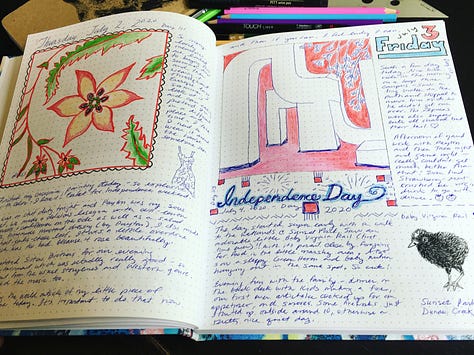



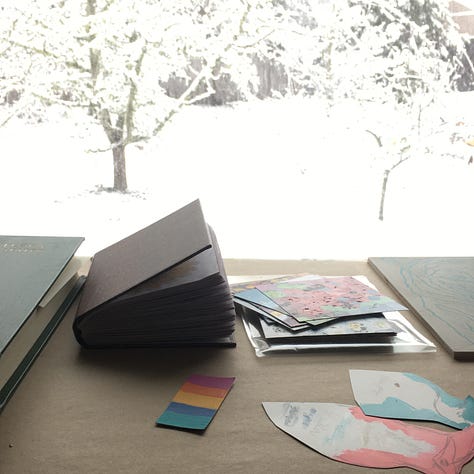
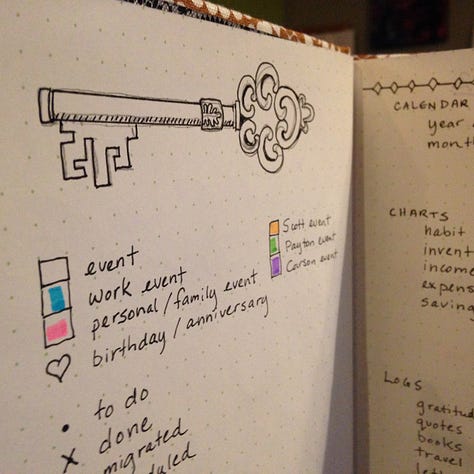
Several years ago, I learned to turn a regular notebook into a painted sketchbook by gluing pages together to create a heavier, more durable surface, thanks to the inspiration of fellow Corvallis artist Rachel Urista. I also learned about a travel sketchbook technique from a collage student this year - whereby you collage scraps onto your sketchbook pages before taking your trip to give you a little jump-start to your daily travel drawing/painting. Brilliant!
With these two thoughts in mind, I found my 2018 bullet journal (the first of the journal photos above) and started gluing pages together.
Three months into the year, I’m still on my first book, but I keep trying to add something to the pages almost every day, even if it’s just a few marks. I now have several spreads “completed,” with wonderful surprises already infiltrating my larger art pieces from this daily practice. I hope to start preparing another bullet journal for the next sketchbook reinvention soon.
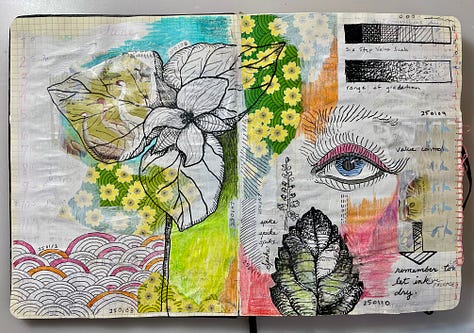
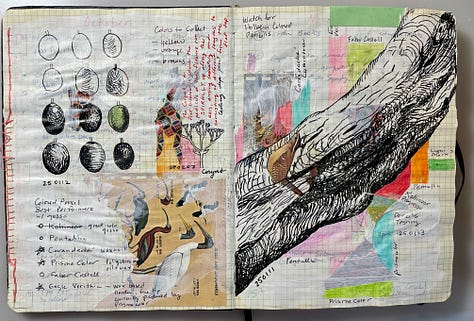

While methodological consistency is not my strength, I am working to fine-tune the steps I take to create each page - making the process more accessible by removing excess choices. I want to focus on building skills while making creative choices that still allow me to stay true to myself - with a colorful sense of immediacy. Acknowledging these pages as a free-play space (within my chosen process boundaries) is helping me to remove judgment from what I create and to let new ideas find opportunities to grow. It’s also helping to develop some cohesion in my work - both on the page and off.
Current Sketchbook Methodology
As the pages (and hopefully newfound skills) continue to develop, I will likely adjust the steps in my process to bring out the qualities that I find most interesting. For now, though, it’s such a pleasure to simply follow a few guidelines while making marks however the mood strikes - fondly remembering the days of Pee-Chees and doodles and no other need to create other than to be engrossed in the act of creating itself.
Sketchbook Preparation
I used PVA glue to bind 2-3 thinner journal pages together - (see note below regarding Methyl Cellulose as an alternative). I tend to use small (about 2-inch) square matboard pieces or cardstock paper scraps to spread the glue across the pages and to the edges. You may have your own favorite technique depending on how secure or how flat you want your page. I’m not too particular, so I don’t spend a lot of time worrying about this step. I will also add stitches along the edge with the sewing machine or with hand embroidery if I want to make the pages more secure when I’m done.
Sketchbook Process
Collage thin, colorful scraps onto the page using a gel medium, or your favorite binder.
Paint a thin layer of white watercolor ground over portions of the page. (Alternatively, I started out using gesso but liked using the watercolor ground when I started adding watercolor and ink washes to the page.)
Choose a technical skill to explore (i.e., botanical illustration or pen and ink drawing techniques.)
Add watercolor or ink washes. (optional)
Repeat/continue step 3.
Add colored pencil and/or conte crayon fields of color/highlights.
Add more ink, pen, or pencil doodles.
Repeat any/all steps as desired.
(As you can see my current process isn’t too stifling or predetermined - Just enough to keep me both grounded and curious.)
Favorite Sketchbook Materials & Inspirations
Collage
Origami paper scraps, vintage fabric patterns, bird books, and stamps
Natural Acrylik Medium (an eco-friendly alternative to traditional gel mediums from Natural Earth Paints)
Glue stick and/or PVA glue. Alternatively, with my next restock, I plan to try Methyl Cellulose, (a natural adhesive from Natural Earth Paints).
Paint
Watercolor Ground (Daniel Smith is my favorite brand and is available in a few options other than the standard bright white, but I am currently using Golden’s QOR brand, which is working well too.)
I enjoy using inks as a wash and/or drawing fluid with a Speedball dip pen or Radiograph pen. My current favorite inks are Dr. Ph. Martin’s Bombay India Ink (used with a brush as a wash or with a dip pen) and Koh-I-Noor Ultradraw Ink (with the dip or Radiograph pen.)
Technical Book Inspirations
Botanical Art Techniques from the American Society of Botanical Artists
Natural History Illustration in Pen and Ink by Sarah Morrish
Pen & Ink Drawing by Alphonso Dunn
(The book links provided are offered through Bookshop.org - of which I am an affiliate and will earn a small commission if you click through and make a purchase. I also encourage you to shop with your local bookstore!)
Drawing Supplies
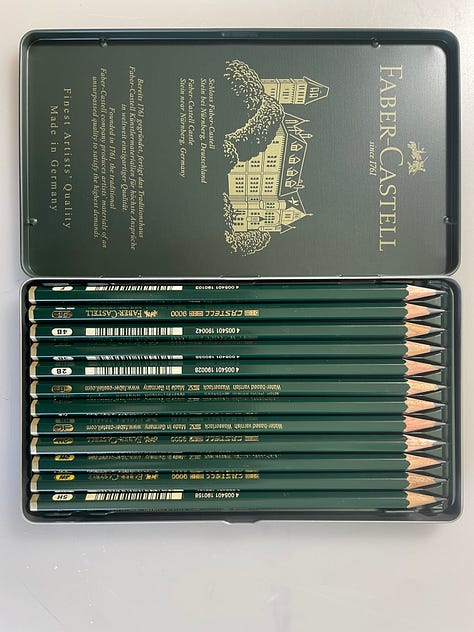

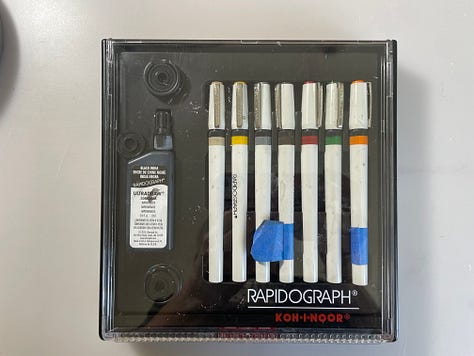
Sketchbook Artists
There are many artists online who regularly share their incredible sketchbook practice. Here are a few I’ve recently found on Substack and enjoyed. Feel free to share others in the comments!
Final thoughts
The first time I added journal pages to my art was for my BFA final showpiece in 1992. The pages were stitched directly onto the canvas, baring my innermost thoughts in a very public display. Somewhere along the way, I lost the courage to express myself as honestly and wholeheartedly as I did then. Maybe it was blind innocence. Maybe a lack of experience or maturity. Maybe it was the decade I worked outside the world of art. But I like to think that this younger version of me was simply braver. It’s taken a lot of work these last few years, but I finally feel like I’m getting to know that courageous young woman once again. With my latest sketchbook efforts, the dialogue happily continues.
Happy creating and sketching,
~ Jennifer (Chopp) Lommers


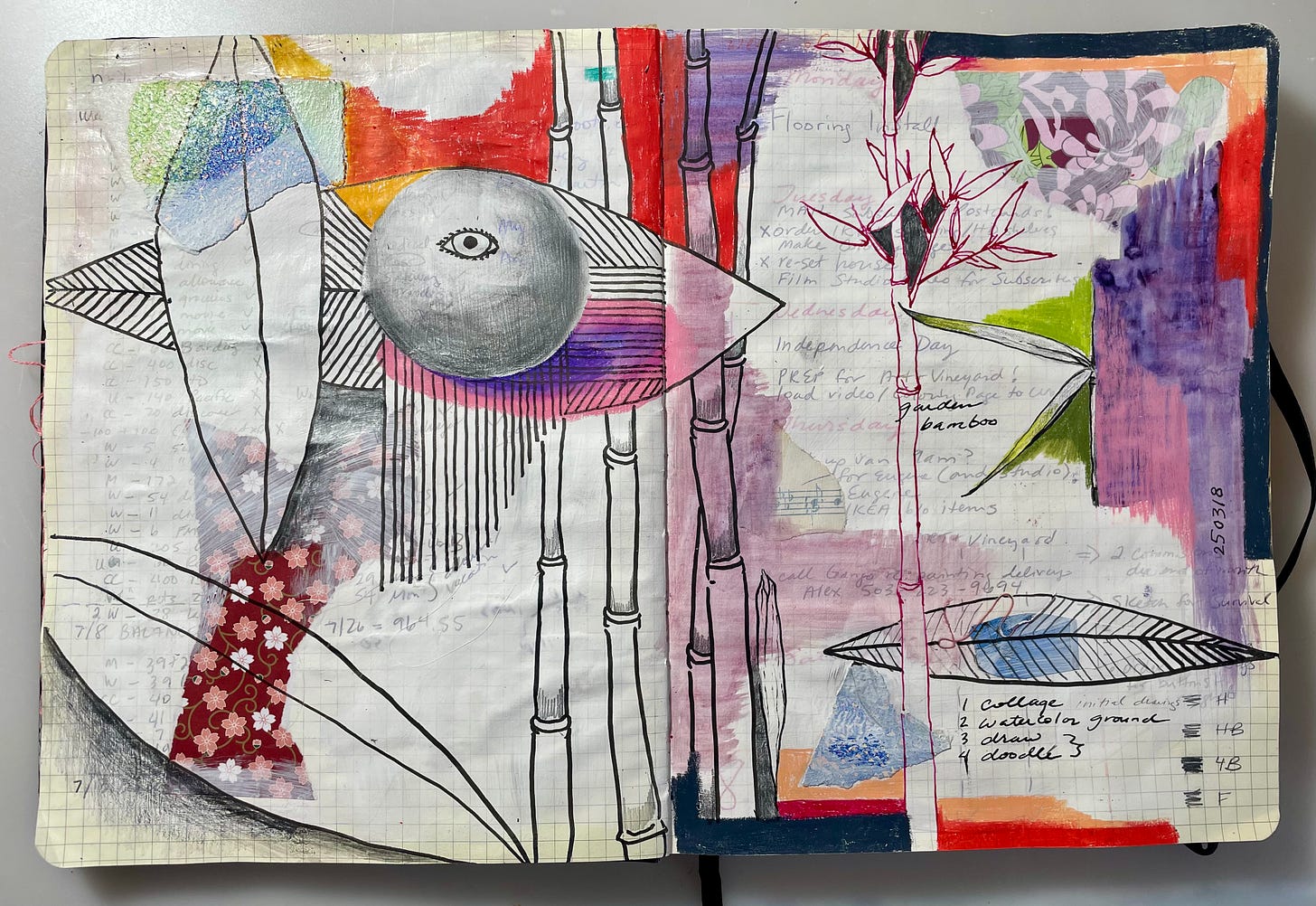


I'm rediscovering mark making after a decade or so away from my paints, and filling my Substack with sketchbook posts like this is bringing me so much inspiration and joy - thank you for sharing 💙
I really enjoyed looking inside your sketchbook. I find it such a freeing space to just experiment and see what happens.